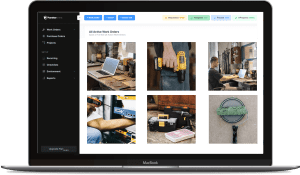Hi, welcome to Panther CMMS Software. Here, you are going to learn more about preventive maintenance. Topics I have covered are what is preventive maintenance, the objectives of preventive maintenance, which equipment to inspect, frequency of inspection, advantages of preventive maintenance and disadvantages of preventive maintenance.
Preventive maintenance is one of the four types of maintenance. PM prevents the breakdown by timely inspection, lubrication, adjustment and repair. In simply we can say, preventive maintenance is maintenance carried out before the breakdown occurs. It tries to minimize problems of breakdown maintenance, which means problems like excessive delay in production, time loss, productivity loss, etc. The maintenance engineer locates the weak spotlight bearing, parts under vibration, part under high temperature, etc. Then inspect and repair them there by reducing the danger of breakdown. I have discussed the breakdown maintenance in another video, check that video in the description. Now come to the objective of maintenance.
- To locating any condition which may lead to a breakdown.
- To make the machinery and equipment always ready to use and maintain their optimum production efficiency.
- To achieve maximum productivity by the minimum repair cost and ensure the safety of workers. Which equipment to inspect. Application of preventive maintenance to all the items is not necessary, there are certain items that are more essential for continuing the production than others. Breakdown of some key item can interrupt the whole production of the plant. For example, process equipment like furnace, compressor, pump, motor, electric wiring, etc. Material handling equipment like cranes, lifts, conveyors, hoists, etc.
Safety equipment like pressure relief valve, fire extinguisher, etc. Frequency of inspection. The frequency of inspection can be decided by past data which was created by a number of experiments. Also the basis of costs and saving of the preventive maintenance program. If the cost is very high then it’s better to reduce the frequency of inspection.
Equipment that is subjected to vibration, overloading, exposure to dirt, fatigue, stress, corrosion is required to inspect frequently. Now move on to the advantages of preventive maintenance which are 1. Reduced breakdown and repair time. 2. Low maintenance cost.
Can PM management help Asset breakdowns?
Absolutely, preventative maintenance is crucial for reducing asset breakdowns. Here’s how it helps:
Identifying Issues Early: Regular maintenance allows you to detect potential problems before they escalate into major breakdowns. By conducting inspections and routine checks, you can catch issues such as worn-out parts or leaks before they cause significant damage.
Increased Asset Lifespan: Regular maintenance ensures that assets are functioning optimally, which can extend their lifespan. By addressing wear and tear promptly and replacing parts as needed, you can prevent premature failure and avoid costly replacements.
Minimized Downtime: Scheduled maintenance reduces the likelihood of unexpected breakdowns, which helps minimize downtime. When assets are properly maintained, they are less likely to fail during critical operations, leading to improved productivity and efficiency.
Cost Savings: While preventative maintenance requires an investment of time and resources upfront, it often leads to significant cost savings in the long run. By avoiding major breakdowns and the associated repair costs, as well as preventing production losses due to downtime, organizations can save money over time.
Safety: Regular maintenance contributes to a safer work environment by ensuring that assets are operating correctly and meeting safety standards. This helps reduce the risk of accidents and injuries caused by equipment failures.
Overall, preventative maintenance plays a vital role in reducing asset breakdowns, improving reliability, and maximizing the return on investment for assets.
Managing preventative maintenance schedules involves several key steps to ensure that assets are properly maintained and breakdowns are minimized. Here’s a structured approach:
Asset Inventory: Begin by creating a comprehensive inventory of all assets that require maintenance. This includes equipment, machinery, vehicles, facilities, and any other relevant assets.
Risk Assessment: Assess the criticality and risk associated with each asset. Consider factors such as the asset’s importance to operations, the frequency of use, potential consequences of failure, and regulatory requirements.
Establish Maintenance Tasks: Determine the specific maintenance tasks required for each asset based on manufacturer recommendations, industry best practices, and historical performance data. This may include routine inspections, lubrication, calibration, cleaning, and component replacements.
Define Maintenance Frequencies: Establish maintenance frequencies for each task based on factors such as asset type, usage patterns, environmental conditions, and regulatory requirements. Some tasks may need to be performed daily, weekly, monthly, quarterly, annually, or on another schedule.
Utilize Maintenance Management Software: Implement a maintenance management system or software to help organize and schedule maintenance activities. These tools can automate scheduling, track work orders, record maintenance history, and generate reports for analysis.
Create a Maintenance Calendar: Develop a centralized maintenance calendar or schedule that outlines upcoming maintenance tasks and deadlines. This calendar should be accessible to maintenance personnel and relevant stakeholders to ensure timely execution of tasks.
Allocate Resources: Allocate resources such as personnel, equipment, materials, and time to support maintenance activities. Ensure that maintenance teams are adequately trained and equipped to perform their assigned tasks effectively.
Monitor and Adjust: Continuously monitor the performance of assets and the effectiveness of preventative maintenance activities. Track key performance indicators (KPIs) such as asset reliability, downtime, maintenance costs, and compliance with maintenance schedules. Use this data to identify areas for improvement and make adjustments to the maintenance program as needed.
By following these steps and implementing a systematic approach to preventative maintenance scheduling, organizations can optimize asset performance, minimize breakdowns, and improve overall operational efficiency.



